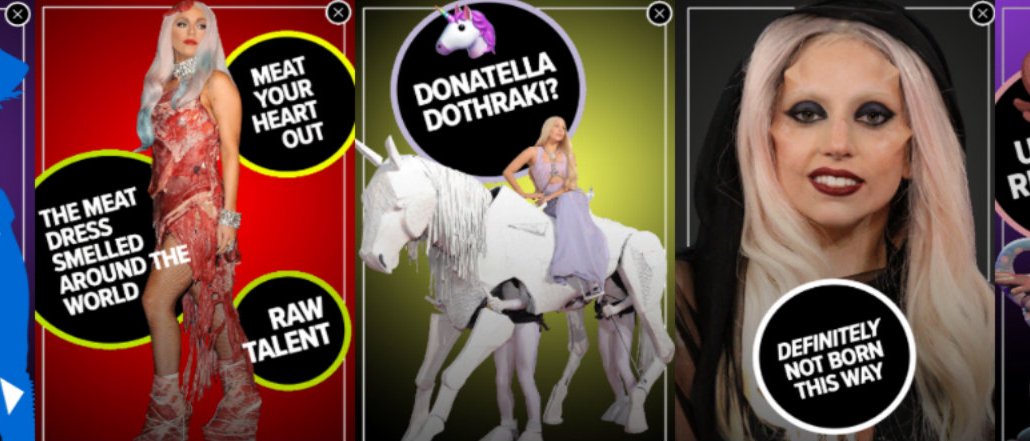Join us Oct. 15-17 in Phoenix to connect with top media buyers
Huffington Post copies Snapchat with new ‘storybook’ format

The Huffington Post is experimenting with its own version of Snapchat and Instagram Stories.
On Monday, February 6, inside of an article about Lady Gaga’s upcoming world tour, The Huffington Post debuted a new visual content format called “storybook,” which listed some of the musician’s more outrageous wardrobe choices. Made for HuffPost’s mobile site (but also available for desktop visitors), the format features ten vertical images and motion graphics that users can swipe or click through. As hinted at in the format’s name, it mimics the vertical content popularized by Snapchat and later Instagram.
“There were some things we were doing on Snapchat and Instagram — the storytelling mechanisms and animations that we can play with on those platforms — that we wanted to bring to readers on our owned and operated platform,” said Emily Ingram, senior product manager at The Huffington Post. “It’s eye-catching in a way that you might not otherwise find on our site.”
A team of seven staffers — Ingram, an editor, three developers and two designers — spent two weeks creating the storybook product, which is now available to everyone in HuffPost’s newsroom through the publisher’s in-house widget-builder platform. Once created, the platform provides an embed code to publish the storybooks inside articles, though HuffPost will also experiment with publishing the format as standalone pieces on its mobile sites and apps.
Initially, Ingram and her product team are working with HuffPost’s multimedia team, which includes social producers, illustrators and motion graphics experts, to create more storybooks. If the format performs well, the publisher expects to get more newsroom staffers involved.
“The best way to get things off the ground is to find a small group of collaborators who are willing to play ball and experiment, and then roll the product out more broadly based on what works,” Ingram said.
HuffPost is confident that storybooks will be a hit, citing the success the publisher had last year in launching a pop-up Snapchat Discover channel centering on sleep. In the 24 hours the Recharge channel was live, it attracted five times as many unique visitors as the average Snapchat Discover channel in April, according to HuffPost. On the first day of the Lady Gaga storybook, 90 percent of users that viewed the third card finished the entire storybook, HuffPost said.
This is not the first time The Huffington Post has experimented with new visual content formats, especially as visitors increasingly access the site on mobile devices. (Mobile by itself accounted for 70 percent of HuffPost’s U.S. traffic in December 2016, which totaled 76.6 million unique visitors, according to comScore.) Last year, HuffPost published two features on Donald Trump and domestic gun violence that presented information on cards that users could swipe or click through.
Other publishers have also adopted features initially popularized by Snapchat. The Washington Post, for instance, now makes vertical videos for its mobile sites and apps. Meanwhile, The Washington Post, Hearst and News Corp are all selling vertical video ads for their platforms.
“I’m a product manager. My job didn’t exist at a lot of news companies five years ago. And if it did, it was strictly a business role,” said Ingram. “But newsrooms are learning that they need to continue pushing themselves forward, to create new products and have the type of skillsets they need on staff to create those products.”
More in Media

In the AI dealmaking rush, Trusted Media Brands is at the table but holding back
Trusted Media Brands is in talks with big tech on AI licensing, but delaying signing deals to avoid giving away content without clear terms.

Inside The Economist’s plan to grow revenues in a post-search, AI-driven future
The publisher is investing in formats that are more difficult for machines to mimic, like video and audio, while holding a hard line against licensing deals with AI firms it views as competitors.

Discord puts proof behind its ad pitch with first measurement push
The measurement test comes a year and six months after Discord rolled out Quests, and is the latest signal that it is going all-in on measurement in 2025 as it moves from experimental campaigns to something advertisers can trust at scale.








